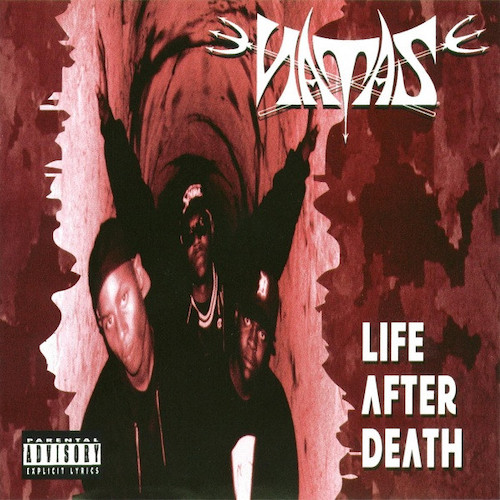Writer DJ Complejo once opined that he was surprised more Esham projects hadn’t been covered on RR over the years, given both the size of his catalogue and the large cult following his work had garnered. I think that was a fair assessment at the time and I’d say it still is a decade and a half later. For my part I think I’m often overwhelmed by just how many albums he has as a soloist or as part of Natas, given that I had no opportunity to buy his albums commercially and didn’t follow his formative years closely due to a lack of exposure on radio and MTV. If I had lived in Eastern Michigan half a decade sooner maybe I would have had a chance, but because of the controversial “horrorcore” nature of his lyrics many record stores outside of his region wouldn’t carry them.
The manufactured furor surrounding the Natas’ album “Life After Death” only exacerbated this problem. The group was blamed for the suicide of a 17-year-old who was allegedly smoking marijuana and playing Russian roulette while listening. It’s patently absurd to blame Esham or Natas for this death. Given the group’s name is Satan spell backward, they were an easy target for scapegoating with white right-wing Christian parents about that “evil rap music” their rebellious children were listening to. Of course this kind of controversy usually benefits the artist in question — see 2 Live Crew, N.W.A and Public Enemy for just a few examples — but given Esham and his crew were on a small indie label a lot of retailers just didn’t want the headache. Esham might sell well in Detroit, but would he move enough units in their stores outside Michigan to make it worth the picket signs and boycotting threats? I can’t be shocked at the choice they made.
With several decades passed since the uproar over “Life After Death” I can report that the outrage was way out of proportion to the content. I’d even go so far as to say that despite being recognized as a progenitor of horrorcore, nothing that Esham or his cohorts Mastamind and T-N-T say here is really that disturbed or twisted. The typical Insane Clown Posse album features far more macabre and purposefully shocking lyrics, specifically crafted to titillate their listeners and rile up the critics who decry their vulgarity (thus ensuring their continued popularity). The irony there is that Esham gained a new and possibly larger following when he eventually signed to Psychopathic Records, giving him a better chance at distribution in major record stores than he ever had before.
Esham lines like “I’m the black devil and that ain’t no joke” and “lick my balls ’til my dick’s numb” on “Get My Head Together” weren’t even shocking in ’92 let alone today. It is a good song though thanks to Esham’s impeccable delivery, unmistakable charisma, and a sample of “Big Sur Suite” also made famous by Black Sheep and the Beastie Boys among others. Coincidentally a Beastie Boys sample of “Paul Revere” is one of the first things I noticed on the alleged suicide inducing title track, right alongside a sample of Prince’s “Let’s Go Crazy” that the Purple One couldn’t have been happy about. It would hardly be the only example though as Mr. Nelson’s “BatDance” was also sampled in a song unsurprisingly called “Dance.” The Zapp and Ice-T samples are far more prominent though.
I’m sure some people were bothered by the unrepentant misogyny of songs like “Bitches On My Mind,” but this too was certainly not unusual for 1992 nor would it be out of place today. With production by Esham simply but effectively looping “Atomic Dog” and Mastamind spitting rapid fire verses about all the trim he wants to get, you could honestly mistake it for a Cali rap song from the likes of DJ Quik or Hi-C. I keep looking for what made this album so ban worthy to so many people all those decades ago and I keep failing to find anything out of the ordinary for a rap group from the era.
In fact what really strikes me about “Life After Death” is how many of the tracks feature Esham in the background as a producer, giving the spotlight to his Natas cohorts instead of hogging it. TNT shows off his potential on the deep bass and slow flowing “I Ain’t Got Shit 2 Lose,” complete with a slowed down sample of “The Message” that perfectly suits the hook. “I take it slow, and go with the flow” intones TNT, and Erick Sermon would be proud of him for living that mantra if he heard the track. This is still dope today.
After examining this album front, back and side to side I can only conclude that the negative reviews Natas garnered at the time were a direct result of backlash over their allegedly Satanic influence on the youth. Putting aside both how absurd the idea music can control people’s minds is and the fact that if Satan was real he’d waste his time convincing rappers to do his dirty work, “Life After Death” is far better than it has ever been given credit for. I wouldn’t say it’s an all-time classic, but it’s ably produced and pleasant to listen to. The rhymes are on point, the samples are well chosen, and every person involved put forth their best effort. Neither Natas nor Esham deserve the hate. This album should be considered on its merits and not because it allegedly caused a death that was only a coincidence.

